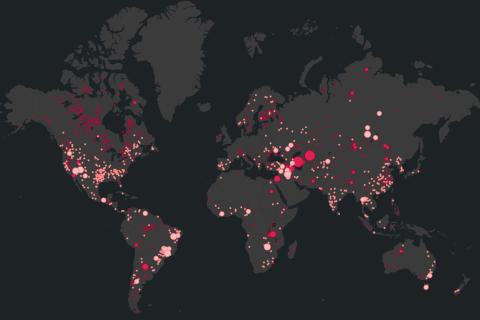Population in drylands could double by 2100 under worst-case climate change scenario
More than three-quarters of the earth's land surface experienced drier climates between 1990 and 2020 compared to the previous three decades, according to a new report by the United Nations Convention to Combat Desertification. Over the past 30 years, 40.6 percent of the global landmass, excluding Antarctica, is classified as drylands, three percentage points more than the previous three decades. The report, which is being presented at the COP16 on desertification being held in Riyadh, Saudi Arabia, also shows that 2.3 billion people were living in drylands in 2020, a population that could rise to 5 billion by 2100 under a worst-case climate change scenario.

César Azorín - informe ONU aridez EN
César Azorín Molina
Researcher at the Climate, Atmosphere and Oceans Laboratory (Climatoc-Lab) at the Desertification Research Centre (CIDE, CSIC-UV-GVA)
The Global Threat of Drying Lands: Regional and global aridity trends and future projections represents a decisive contribution on the state of our planet's drylands. The report is a pioneering effort by the UNCCD [United Nations Convention to Combat Desertification] and its partner countries, as it provides for the first time a scientifically rigorous review, assessment and attribution of global aridity trends and future projections. The report provides projections of impact scenarios, as well as explores potential actions for mitigation, prevention and adaptation to aridity. This report is undoubtedly a turning point in the assessment of global trends in aridity, substantiated with sound science based on advanced climate models and standardised methodologies for their quantification.
Aridity is a persistent climatic condition determined by a long-term lack of moisture that affects both ecosystems and human activities. Unlike droughts, which are a temporary phenomenon of water scarcity, aridity is a permanent state. The report concludes that aridity currently affects 40.6% of the Earth's land surface (excluding Antarctica), and 77.6% has increased over the period 1991-2020 compared to the previous climate period (1961-1990). In addition, the report notes that 4.3 million km2 of wetlands have been transformed into drylands in the last 30 years. The increase in the extent of drylands has a high socio-economic impact, affecting 30.9% (2.3 billion) of the world's population.
The report states that the increase in aridity is associated with anthropogenic climate change, and that drylands have increased by 1.5 million km2 since the industrial revolution (1850) due to greenhouse gases and global warming. These observed changes in the increase of the planet's drylands are also projected into the future, intensifying according to different socio-economic development scenarios. Under a medium scenario (SSP3), it is estimated that 7.2% of the Earth's land surface will become drylands, and 2% of wetlands will become drylands. This percentage will increase to 9.2 % under a high scenario (SSP5) by the end of this century. The report notes that this increase in aridity will affect all continents by increasing the number of people exposed to and living in them, mainly in Africa, Asia, Latin America and the Caribbean under SSP3, and Europe, North America and Oceania under SSP5. The Mediterranean area, and in particular Spain, are critical regions for this increase in aridity, which is projected to continue to increase over the course of this century if anthropogenic carbon emissions are not reduced.
Based on a comprehensive review of more than 400 scientific papers, the report concludes that the socio-economic and environmental impacts of increased aridity will span a wide range of sectors, from agriculture, biodiversity, forest fires, water availability, migration, desertification, poverty and health, among many others. The report concludes on the urgency of adopting adaptation measures to combat the effects of increasing aridity on the planet, from the sustainable use of irrigation water, new agricultural and grazing practices, or the development of climate services as a useful tool for aridity monitoring and decision making.
In short, it is a solid report based on scientific evidence and demonstrates the urgency of adopting measures in the face of the relentless increase in aridity on the planet.
Conflict of interest: César Azorín has co-signed publications with Sergio Vicente, one of the authors of the report.
Vicente-Serrano, S. M. et al.
- Report
- Peer reviewed



